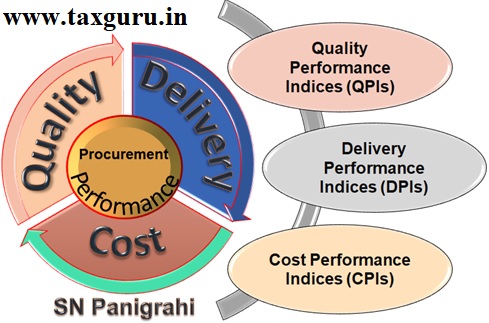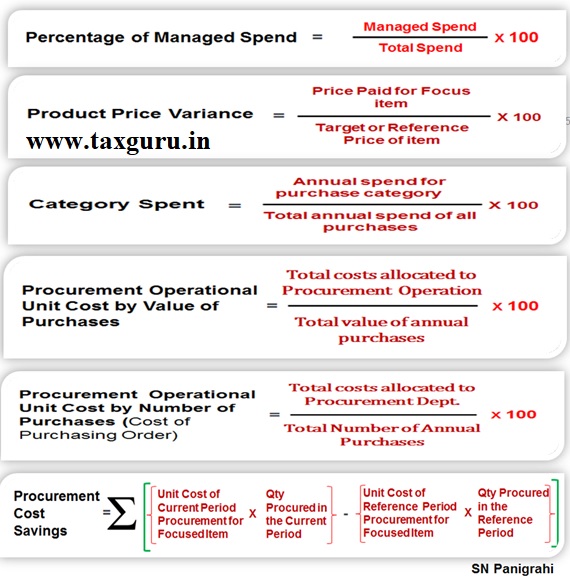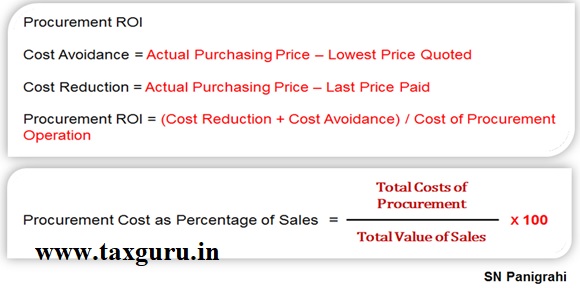Performance Measurement is generally defined as Regular Measurement of outcomes and results, which generates reliable data on the Effectiveness and Efficiency of Performance.
Performance indices are derived based on the trade-off between a constraint and the free variable. Performance Index is a measurable value that demonstrates how effectively a company or functional department is achieving key business objectives.
Procurement Performance analysis sets its focus on Measurable Parameters to Gauge Performance of Procurement Functions. Procurement Performance Indices (PPI’s) presented here are used to assess progress in achieving pre-established procurement performance goals and targets in the three major groups of Quality, Delivery, Cost (QDC).

Accordingly, there are three broad categories of indices.
> Quality Performance Indices (QPIs)
> Delivery Performance Indices (DPIs)
> Cost Performance Indices (CPIs)
Some of the major Performance Indices for each of the QCD are discussed below.
Quality Performance Indices (QPIs):
These indices identify performance of goods or services using certain attributes to improving level of quality.
Products and services of low quality would affect an organizations product quality which might add additional costs. Quality Performance Indices (QPIs) Metrices sets quality standard such as percentage of rejections. Some of the Quality Performance Indices (QPIs) are shown here.

Delivery Performance Indices (DPIs):
Delivery performance provides an indication of how successful the supply base is at providing products and services to the concerned stakeholders to improve delivery as well as continuity of supply. These metrics are most important in the measurement of performance of the procurement function and are important for organizations, as late deliveries might affect supply chain continuity, early deliveries can result in higher operational/Inventory costs. The goal is to have lower number of errors against the requested time frame for deliveries. Deliveries that are on time helps to Maintain continuity, improve inventory management which leads to cost savings. Some of Delivery Performance Indices (DPIs) are shown below:

Cost Performance Indices (CPIs):
These are measures of the efficiency of expenses spent and also effectiveness of the procurement function on cost related aspects like actual cost spend and savings etc.
One of such Indices is Measuring the percentage of managed spend against total spend on purchases for external products and services. Managed spend can be calculated as the sum of all spend run by an organization. Goal of these Indices are to have more spend standard procedures, thereby saving on costs.
Similarly Reducing Consumption to determine if it’s necessary, an organization can exclude things that they can they can do without or substitute, for example the reduction of travel expenses by deployment of video conferencing. Consolidation of spend hidden costs can arise if specifications are harmonized or Standardized.
Some of Cost Performance Indices (CPIs) are

–

These indices also serve as KPIs (Key Performance Indicators) to gauge performance of Procurement personnel. Procurement KPIs are management tools designed to monitor procurement department performance and help meet goals, strategies and objectives. The primary goal of every procurement organization is keeping the procurement sustainable and constantly looking for ways on how to improve the procurement processes and performance. Some of these Indices may be used by procurement functions by suitably modified as per the individual organizational requirements.
The article can be Viewed on SlideShare @ Below Link
Also can be Viewed on YouTube @ Below Link
To get Time to Time Updates on SCM, Procurement, GST, Foreign Trade, Projects, Lean & Six Sigma etc Pl Subscribe to Below YouTube Chanel
https://www.youtube.com/channel/UCVZScNa_leR8XbYINEwTFwQ/videos





